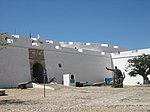Church of Our Lady of Remedies
1620s establishments in Africa1628 establishments in the Portuguese Empire17th-century Roman Catholic church buildings in AngolaAfrican church stubsAngolan building and structure stubs ... and 5 more
Catholic Church in AngolaRoman Catholic cathedral stubsRoman Catholic cathedrals in AngolaRoman Catholic churches completed in 1628Roman Catholic churches in Luanda

The Church of Our Lady of Remedies (Portuguese: Igreja de Nossa Senhora dos Remédios) is a Roman Catholic cathedral in Luanda, Angola. It was built in 1628 and is the seat of the Roman Catholic Archbishop of Luanda. In 1716 the headquarters of the Diocese of Angola and Congo was transferred from São Salvador of Congo to Luanda, which eventually led the church of Dos Remedios to become cathedral. In 1877 it was in ruins and restored between 1880 and 1900. At that time acquired the present appearance, as three doors and a curved pediment on the façade. In 1949 it was declared a Public Interest, when it was still part of the Portuguese colonial empire.
Excerpt from the Wikipedia article Church of Our Lady of Remedies (License: CC BY-SA 3.0, Authors, Images).Church of Our Lady of Remedies
Travessa da Sé, Luanda Kinanga
Geographical coordinates (GPS) Address External links Nearby Places Show on map
Geographical coordinates (GPS)
| Latitude | Longitude |
|---|---|
| N -8.8136111111111 ° | E 13.229722222222 ° |
Address
Sé Catedral-Paróquia dos Remédios (Igreja da Nossa Senhora dos Remédios)
Travessa da Sé
Luanda, Kinanga
Luanda Province, Angola
Open on Google Maps







